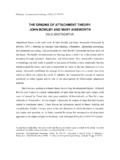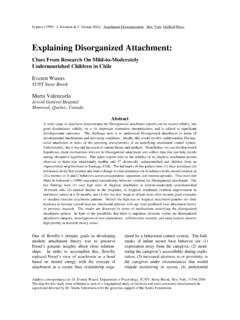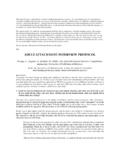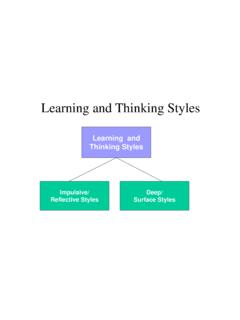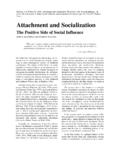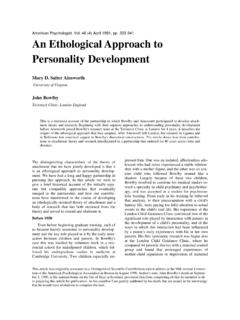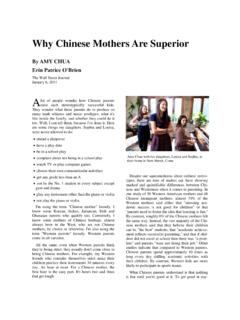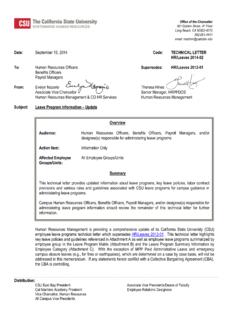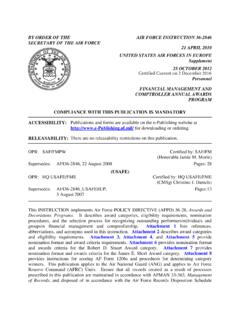Transcription of A Review of Adult Attachment Measures: Implications for ...
1 Crowell, & Treboux, D. (1995) A Review of Adult Attachment measures: Implications for theory and re-search. Social Development. 4. 294-327. A Review of Adult Attachment Measures: Implications for Theory and Research Judith A. Crowell and Dominique Treboux State University of New York at Stony Brook Abstract There has been increasing interest in Adult Attachment from both theoretical and empirical perspectives. Be-cause the test of a theory is based on our ability to assess theoretical constructs, the Review is organized around assessment techniques. Delineating the content, focus, assumptions, and correlates of different Attachment measures highlights central issues and problems in conducting research in Adult Attachment . In this Review , we present theoretical issues related to Adult Attachment , in particular, individual differences, working models, and the role of Attachment in Adult life. A summary of the measures commonly used in the study of Adult at-tachment follows.
2 The literature Review is organized by measure , examining topics such as relations between childhood experiences and Adult Attachment status, and Adult Attachment and Adult personality and function-ing, parenting and partnership behavior. Studies which explore relations between measures are discussed be-fore concluding with thoughts about future directions. Key words: Attachment , Adult Attachment , marriage, working models Acknowledgments: We thank Everett Waters for his provocative and challenging ideas which have led to greater understanding of Attachment theory and issues of Adult Attachment , and Kim Bartholomew and the anonymous reviewers for their helpful comments and suggestions. Requests for reprints should be addressed to Dominique Treboux, , Psychology B, SUNY-Stony Brook, NY, 11794 2 A Review of Adult Attachment Measures: Implications for Theory and Research The past few years have seen a rise in interest in Adult Attachment from both theoretical and empirical perspec-tives.
3 The research draws upon Bowlby's theory of Attachment (Bowlby, 1969/1982; Bowlby, 1973; Bowlby, 1980), and has gone in several directions, examining (1) the relation between childhood Attachment experiences and parenting behavior, and intergenerational transmission of Attachment patterns, (2) the impact of childhood Attachment experiences on Adult relationships, and the role of Attachment in Adult - Adult relationships, and (3) the role of working models or representations of Attachment in influencing thoughts, feelings, and behavior in the two domains of Adult functioning: parenting and romantic relationships. This Review addressed some key issues in Adult Attachment which have arisen from the recent proliferation of research and controversy about the topic. Because the test of a theory is based on our ability to assess theoretical constructs, the Review is organized around assessment techniques. Delineating the content, focus, assumptions, and correlates of different Attachment meas-ures highlights central issues and problems in conducting research in Adult Attachment .
4 Moreover, it forces us to look closely at Bowlby's theory and its postulates, and reminds us that the theory makes specific hypotheses about the Attachment behavior system, and it is not a theory of parenting, infant development, personality, relationships, or a general theory of all good things. In this Review , we present theoretical background, including issues related to individual differences, working models, and the role of Attachment in Adult life. A summary of the measures used in the study of Adult attach-ment follows, including a table of basic information allowing comparisons among the measures. The literature Review is organized by measure , examining topics such as relations between childhood experiences and Adult at-tachment status, and Adult Attachment and Adult personality and functioning, parenting and partnership behavior. Studies which explore relations between measures are discussed, before concluding with thoughts about future directions.
5 Theoretical Background What is the Attachment behavior system? Bowlby described the Attachment behavior system as a motivational control system which has the goal of promot-ing safety and felt security in infancy and childhood through the child's relationship with the Attachment figure or caregiver (Bowlby, 1969/1982). Attachment behaviors are the observable elements of the system (crying, calling, clinging, searching, etc.), and reflect "the activation of an inferred and not directly observable Attachment behav-ior system (Stevenson-Hinde, 1994), p. 62. The system is activated in times of danger, stress, and novelty, and has the outcome of gaining and maintaining proximity to and contact with the Attachment figure. The Attachment figure promotes Attachment behavior by being available, responsive, protective, and comforting when a threat or stressor presents itself (Waters,Kondo-Ikemura,Posada, & Richters, 1991). The availability, responsiveness, and active support of the caregiver allows the child to confidently explore the environment under ordinary circum-stances, secure in the knowledge that the Attachment figure is there should any need arise.
6 What are individual differences in Attachment behavior? Individual differences in organization of Attachment behavior and in expectations regarding Attachment relation-ships are hypothesized to be related in large part to behavior of the Attachment figure (versus child characteristics such as temperament), and the patterns of Attachment are broadly characterized as secure and insecure (Ainsworth,Blehar,Waters, & Wall, 1978; Bretherton, 1985). The secure pattern fits the description above in that the infant seeks and receives protection, reassurance, and comfort when stressed. Confident exploration is optimized because of the support and availability of the care-giver. The insecure patterns (avoidant, ambivalent, disorganized) develop when Attachment behavior is met by rejection, inconsistency, or even threat from the Attachment figure, leaving the infant "anxious" about the care-giver's responsiveness should problems arise.
7 To reduce this anxiety, the infant's behavior comes to fit or comple-3 ment the Attachment figure's behavior, in other words, it is adaptive or strategic within that relationship. For ex-ample, the infant whose Attachment behavior has been routinely rejected develops an insecure/avoidant attach-ment pattern. When presented with a stressful experience the infant avoids contact with or even looking at the Attachment figure, minimizing the expression of distress in the situation and precluding rejection from the care-giver (Main, 1981; Main & Goldwyn, 1984). In contrast, the insecure/ambivalent pattern is associated with heightened Attachment behavior in the face of an inconsistent Attachment figure (Cassidy & Berlin, 1994). Consistent with Attachment theory, the patterns of Attachment are relatively stable across time in samples from the general population (as opposed to at-risk samples) (Main & Cassidy, 1988; Waters, 1978; Waters,Crowell,Treboux,Merrick, & Albersheim, 1995).
8 As the child develops, there is an assumption of continuity of parental care, which contributes strongly to the stability of the Attachment pattern (Bretherton, 1985). In childhood, if an Attachment pattern changes, there should be a corresponding change in the quality of parent-child interactions (Bowlby, 1969/1982). Bowlby suggests that change in Adult life is also possible. He hypothesized that change could occur through the influence of new emotional relationship and the development of formal operational thought; this combination of events would allow the individual to reflect on and reinterpret the meaning of past and present experiences. What are working models or representations of Attachment relationships? A central developmental hypothesis in Attachment theory is that early parent-child relationships are prototypes of later love relationships, a Freudian insight preserved and modified by Bowlby (Waters et al.)
9 , 1991). Bowlby does not imply that there is a critical period in infancy which has Implications across the lifespan (which would be the most extreme interpretation of a prototype hypothesis), but rather that there is a strong tendency for continuity of parent-child interactions which then feed back into the Attachment behavior system. That is, in addition to effects on individual personality characteristics, child-parent relationships should be related to subsequent patterns of family organization and play a role in intergenerational transmission of family patterns. Working models of Attachment relationships are cognitive/affective constructs which develop in the course of be-havioral interactions between the infant/child and its parents. As noted above, individual differences emerge in the expression of Attachment behavior in the context of Attachment relationships. Initially patterns of Attachment reflect expectations about the parent's likely behavior in various situations.
10 Eventually the child abstracts from these expectations a set of postulates about how close relationships operate and how they are used in daily life and in stressful circumstances. These cognitive constructs are called "working" models because they are the basis for action in many situations and because in principle they are open to revision as a function of significant Attachment related experiences. An individual's model of Attachment involves postulates about both the parent and child role in relationships; in other words, it is a model of the relationship and "even when the models of self and other have become distinct, they represent obverse sides of the same relationship and cannot be understood without reference to each other" (Bretherton, 1985), p. 12. The models are relatively stable constructs which operate outside awareness, guide behavior in relationships with parents, and influence expectations, strategies, and behavior in later relation-ships.
